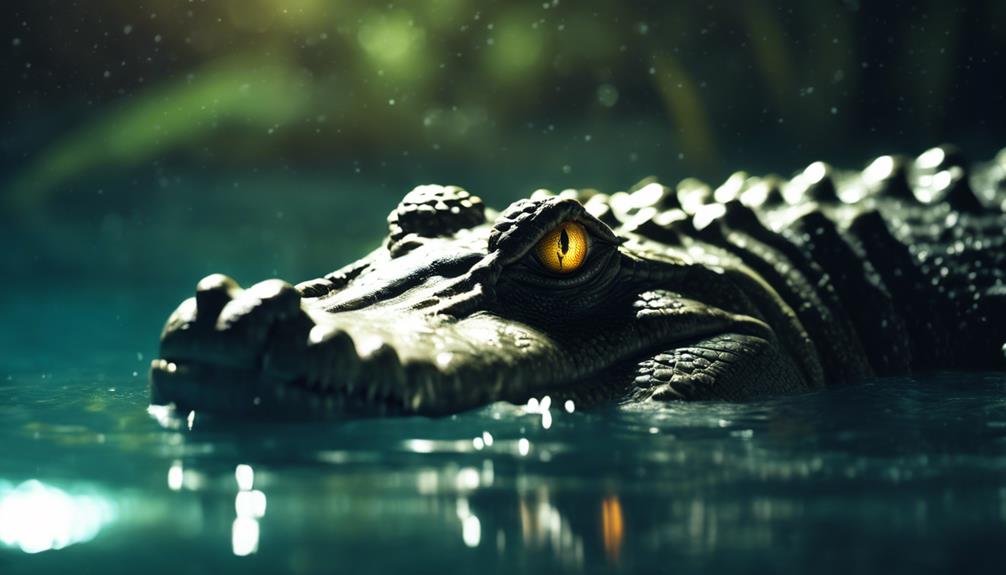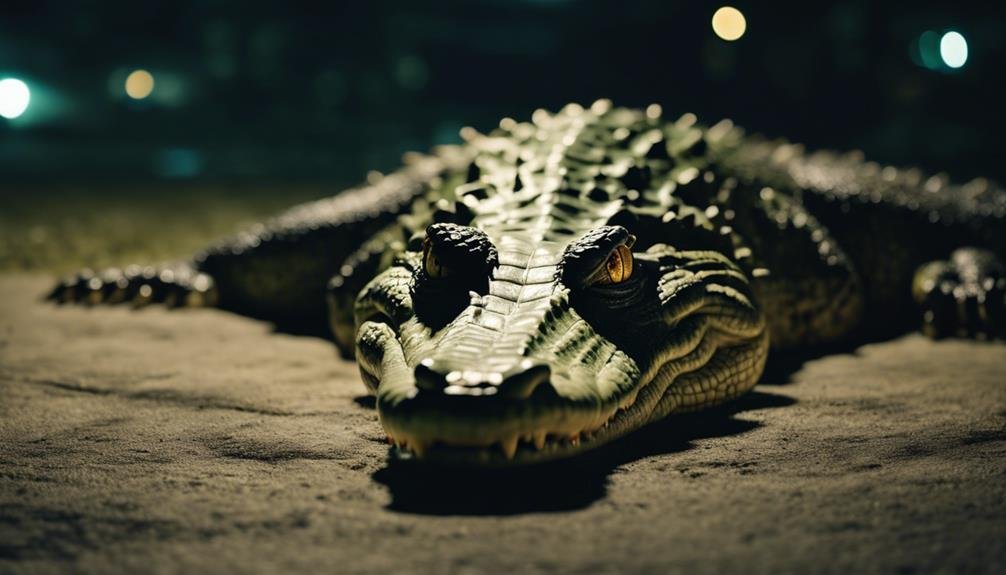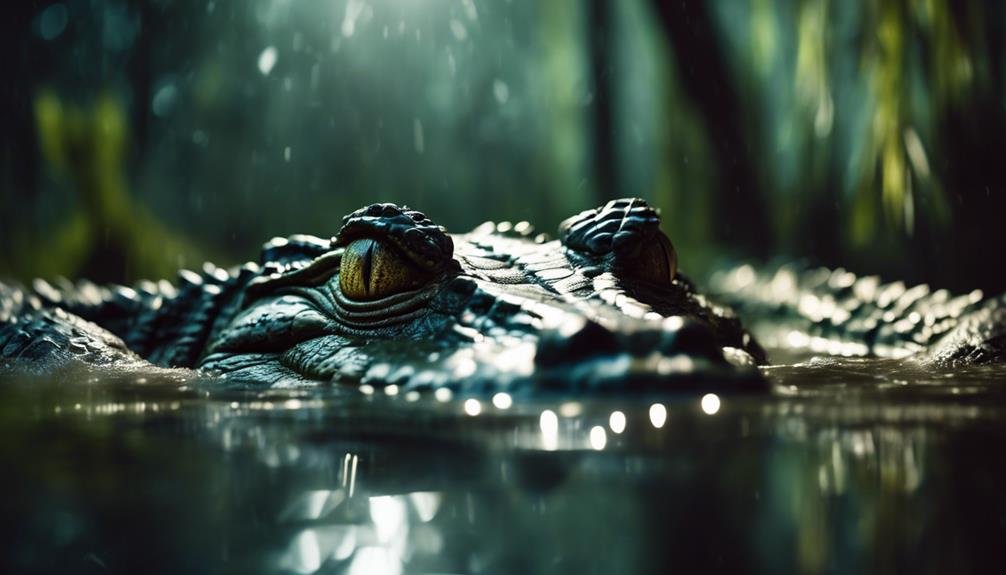Have you ever wondered how crocodiles are such efficient predators, especially under the cloak of night? Well, it turns out that their eyesight, particularly their night vision, plays a pivotal role. Equipped with a complex anatomy that includes a specialized fovea, a high density of rod cells, and the reflective tapetum lucidum, crocodiles can see in conditions where most would be unthinkingly groping in the dark. How do these features work together to give crocodiles this almost superhuman ability? And more intriguingly, what does this mean for their hunting strategies and survival in the wild? Let’s explore the fascinating world of crocodile vision and uncover the secrets behind their nocturnal supremacy.
Key Takeaways
- Crocodiles have specialized rod cells and a tapetum lucidum, enhancing their night vision.
- Their vertical-slit pupils adjust to control light intake, improving visibility in murky waters.
- They possess a unique ability to differentiate colors at night, aiding in prey detection.
- Adaptations like a sharp fovea and foveal streak ensure precise low-light vision.
- As dominant nocturnal predators, these features collectively make crocodiles’ night vision exceptionally good.
The Anatomy of Crocodile Eyes
Crocodile eyes, equipped with a specialized fovea, offer sharp vision along the visual horizon, essential for spotting prey while lurking just above the water. This unique adaptation allows you to stay almost completely submerged, with just your eyes peeking out, yet keep a clear view of potential meals passing by. The fovea, a small pit packed with photoreceptor cells, gives you this edge. It’s like having built-in binoculars that zero in on movement across the water’s surface without revealing your presence.
Your eyes aren’t just about the fovea, though. They’re part of a larger system designed for your semi-aquatic lifestyle. While you might think your vision isn’t up to par compared to a human’s, it’s exactly what you need for your hunting tactics. The foveal streak across your retina enhances this capability, allowing for an extended sharp vision area that matches your environmental needs. This design isn’t about seeing the world in high definition but about ensuring you never miss a beat—or a bite—when it comes to catching your next meal.
Night Vision Superiority
Your exceptional night vision, bolstered by a high concentration of rod cells in your retinas, sets you apart in the animal kingdom, enabling you to excel in the dark environments you often traverse. This natural gift lets you see with incredible clarity when the sun goes down, turning the night into your playground. The secret behind your night vision superiority isn’t just the rod cells, though they play a pivotal role.
The tapetum lucidum, a layer behind your retina, acts like a mirror. It reflects light through the retina, giving you a second chance to use that light. This reflection enhances your ability to see in low-light conditions, making you an efficient hunter. Your vertical-slit pupils are another marvel, finely tuning the amount of light that enters your eyes. This control is essential for exploring the murky waters and shadowy landscapes where you reign supreme.
Moreover, your ability to differentiate colors at night isn’t just rare; it’s a game-changer. It gives you an edge in identifying prey and understanding your environment, further cementing your status as a nocturnal predator. Through these adaptations, you’ve become an unmatched master of the darkDarkd Cells and Their Role


The secret to revealing the mysteries of the nightlies is often in the remarkable role of rod cells within the retina. These specialized cells are your crocodile’s ticket to unparalleled night vision. Rod cells are the unsung heroes for detecting low light levels, allowing these ancient predators to thrive in the dimmest conditions. They’re incredibly light-sensitive, which is exactly why crocodiles can easily navigate dark waters.
Crocodiles have a high density of these rod cells in their retinas, a feature tailor-made for their nocturnal hunting escapades. This abundance isn’t just for show; it’s what gives crocodiles their edge, enabling them to see in conditions that would leave others blind. Imagine the advantage this provides during a moonless night hunt—rod cells allow them to spot their prey and navigate their environment with precision.
Tapetum Lucidum Explained
Diving deeper into the anatomy of exceptional night vision, the tapetum lucidum stands out as an essential feature in crocodiles. It reflects light back through the retina to enhance their ability to see in low-light conditions. This unique layer acts like a mirror inside their eyes, doubling the chances for light to hit the photoreceptor cells. It’s what gives crocodiles their impressive night vision capabilities, setting them apart from humans and many other species.
The tapetum lucidum maximizes the light available, making the most of dim environments. This adaptation is vital for crocodiles, enabling them to detect movement and locate prey more effectively when the sun goes down. It’s a game-changer for these nocturnal hunters, providing them with a significant advantage in the darkDarkund in many animals that thrive at night, the tapetum lucidum is a key factor in the ability to see in the darkDarkwever, crocodiles are among the elite with this feature, showcasing superior night vision that few can match. Their eyes are specially designed for the darkness, making them formidable predators after dusk.
Hunting in Darkness


Crocodiles’ exceptional night vision is key to their prowess in hunting under the cover of darkness.
Their eyes are tailor-made for nocturnal hunting, equipped with adaptations like the tapetum lucidum that greatly enhance their ability to see in low light.
This makes them survivors and dominant predators when the sun goes down.
Night Vision Strength
One can’t help but marvel at crocodiles’ essential night vision, which empowers them to hunt with remarkable efficiency in the cover of darkness. Their ability to navigate and pinpoint prey at night is largely due to the advanced features of their eyes. The tapetum lucidum, a reflective layer nestled behind the retina, enhances night vision. It acts like a mirror, reflecting any available light through the retina, magnifying its ability to see in low light conditions.
Moreover, crocodiles’ vertical-slit pupils and highly sensitive retinas further augment their night vision. These adaptations allow them to detect slight movements and subtle environmental changes, making them formidable nocturnal hunters. The synergy of these features enables crocodiles to track and capture prey with precision, even in the dead of night.
Adaptations for Nocturnal Hunting
Crocodiles rely on remarkable adaptations to hunt effectively at night, such as their tapetum lucidum and vertical-slit pupils. The tapetum lucidum, a layer behind the retina, reflects light back through the eyes, dramatically enhancing their night vision. This means they can see with just a fraction of the light you’d need, making them formidable nocturnal hunters.
Their vertical-slit pupils aren’t just for show; they sharpen depth perception in low light, ensuring crocodiles precisely gauge the distance to their prey. Adaptability to different light intensities allows them to seamlessly shift from daylight to darkness, keeping their eyes primed for any movement.
This exceptional night vision enables them to detect and ambush targets in the dark. Darkh has astonishing efficiency.
Navigating Nocturnal Waters
Equipped with exceptional night vision, crocodiles skillfully navigate nocturnal waters for their next meal. Thanks to many rod cells in their retinas, they dominate the dark, dark marketing that lesser actors would miss. The secret to their adeptness lies in these cells and a special layer called the tapetum lucidum. This reflective surface sits snug behind the retina, bouncing light back through the eyes, giving everything a second chance to be seen, even in the dimmest conditions.
You’d be amazed at how these ancient hunters use their eyes like sophisticated night-vision gear. Their vertical-slit pupils aren’t just for show; they’re precision tools for judging distances accurately in the critical ability when stalking prey. And it doesn’t stop there. Crocodiles can even see colors in low light, which helps them distinguish between different types of prey or objects in the water. Imagine detecting the slightest movement or color variation in the pitch-black water—a night in the life of a crocodile, perfectly designed for nocturnal dominance.
Comparing Crocodile Vision


When comparing the vision of crocodiles to other animals, it’s clear that their unique adaptations give them a significant edge in nocturnal hunting. These predators boast excellent night vision thanks to a tapetum lucidum, a reflective layer behind the crocodile retina. This feature amplifies light, allowing them to see in conditions that would blind other species. Additionally, their vertical-slit pupils aren’t just for show; they provide depth perception, which is important for judging distances accurately during a hunt.
Crocodiles don’t just rely on their night vision. They can differentiate colors, which enhances their ability to spot prey and navigate their murky aquatic environments effectively. The presence of a fovea in the crocodile retina sharpens their vision along the visual horizon, enabling them to spot potential prey from afar without needing to move. Saltwater crocodiles, in particular, have adapted their vision for underwater hunting. Their color photoreceptors are shifted to shorter wavelengths, improving visibility in underwater conditions. This adaptation ensures they remain formidable predators, capable of finding their way and hunting in various lighting conditions.
Can Crocodiles See Well in the Dark, Given Their Large Number of Teeth?
Yes, saltwater crocodile teeth count can be numerous, sometimes reaching up to 64 teeth in their jaws. Despite their impressive dental array, their eyesight truly sets them apart. Saltwater crocodiles have excellent night vision, allowing them to see well in the dark and hunt for prey.
Conclusion
To conclude, you’ve witnessed how crocodiles flaunt remarkable night vision thanks to their unique eye anatomy. Their specialized fovea, high density of rod cells, and reflective tapetum lucidum all play vital roles.
You’re now aware that these adaptations enhance their sight in the dark and make them skilled nocturnal hunters.
Compared to other creatures, crocodiles are equipped with one of nature’s most effective visual systems for traversing and dominating nocturnal waters.
FAQs
1. Do Crocs Have Good Night Vision?
Yes, crocs do have good night vision! Their eyes are specially adapted to see clearly in low light, making them formidable nocturnal hunters.
They’ve got many rod cells and a reflective layer called the tapetum lucidum, which boosts their ability to see at night.
While their color perception and daytime vision are also decent, their night vision sets them apart in the animal kingdom.
2. Do Crocodiles Have Night Vision?
Yes, crocodiles do have night vision, and it’s quite extraordinary! Their eyes are equipped with rods and a tapetum lucidum to see in low light, making them formidable nocturnal hunters.
4. Do Crocodiles Eyes Shine at Night?
Yes, crocodiles’ eyes do shine at night. This glow comes from a special part of their eye called the tapetum lucidum. A reflective layer sits behind the retina, bouncing light back through it.


